Hello all, I've been a member of this blog for some time now but never actually managed to post anything to it (sorry!). So here's my first attempt: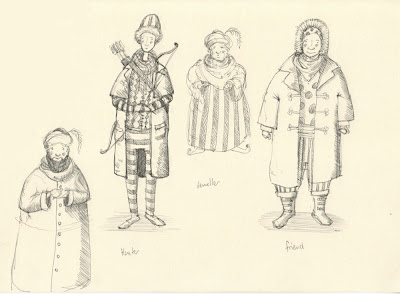
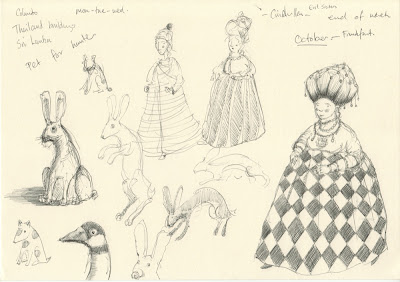

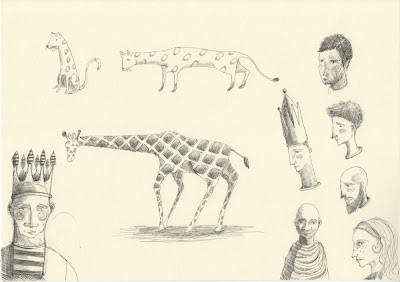
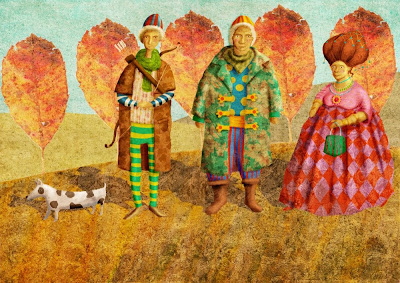
These are some sketches and a coloured piece for a new book. These won't appear in the finished product, I'm just trying out characters and techniques. Drawings are in biro, coloured piece is all digital.
If you want to see more of my stuff follow the links below (if my website doesn't work, try again later, it's hosted on .Mac which is becoming MobileMe this week and keeps on not working)....
My website
My blog
Viewing: Blog Posts Tagged with: by the decades challenge, Most Recent at Top [Help]
Results 1 - 25 of 25
Blog: Picture Bookies Showcase (Login to Add to MyJacketFlap)
JacketFlap tags: sketches, jago, jago illustration, goose fables, mantra lingua, Add a tag
Blog: Jago Illustration (Login to Add to MyJacketFlap)
JacketFlap tags: Mantra Lingua, character, Add a tag
Blog: Jago Illustration (Login to Add to MyJacketFlap)
JacketFlap tags: Sketch, Goose Fables, Mantra Lingua, Add a tag
Blog: Jago Illustration (Login to Add to MyJacketFlap)
JacketFlap tags: Goose Fables, Mantra Lingua, Add a tag
Blog: Jago Illustration (Login to Add to MyJacketFlap)
JacketFlap tags: new work, Goose Fables, Mantra Lingua, Add a tag

Here's some of the first sketches for a new book...
Blog: Becky's Book Reviews (Login to Add to MyJacketFlap)
JacketFlap tags: classic, Zora Neale Hurston mini-challenge, by the decades challenge, 888 Challenge, Add a tag
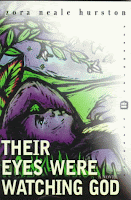
 Hurston, Zora Neale. 1937. Their Eyes Were Watching God.
Hurston, Zora Neale. 1937. Their Eyes Were Watching God.
If ever a book is going to grab you at 'hello', let it be Their Eyes Were Watching God by Zora Neale Hurston.
This book, which I just recently finished reading for my online reading group, has to be one of my favorite, favorite, favorite, favorite books of all time. (Yes, it's right up there along with Ender's Game by Orson Scott Card and Frankenstein by Mary Shelley.) I first "discovered" Zora Neale Hurston by force. She was required reading in a short story course I was taking in the Fall of 1997. When I signed up for the course, I was not an English major. I was just looking to fulfill the core requirements. (The very fact that I was in that class was an accident because of schedule conflicts and classes having to be changed, rearranged, etc. at the last moment. One thing I don't miss about college is the hassle of registering for classes, having some be canceled and having to scramble to find something new at the last minute.) By the end of the semester, however, I had changed majors and chosen to walk down a new path. (Zora Neale Hurston wasn't solely responsible, however, she had help from some other greats.) Hurston kept popping up on reading lists in college. A short story here and there. And then there came the novel--Their Eyes Were Watching God--I honestly don't remember if it was assigned reading just once or if I read it twice 'officially' (meaning for a grade). But regardless, it was love. I've read this one at least four or five times since that first introduction.Ships at a distance have every man’s wish on board. For some they come in with the tide. For others they sail forever on the horizon, never out of sight, never landing until the Watcher turns his eyes away in resignation, his dreams mocked to death by Time. That is the life of men.
Now women forget all those things they don’t want to remember, and remember everything they don’t want to forget. The dream is the truth. Then they act and do things accordingly. (1)
The story. At the heart of the story is a woman. Janie. Except for the very briefest introductions, we first meet Janie as a young woman, sixteen or seventeen and just awakening to the possibilities of love and life and passion.
Oh to be a pear tree–any tree in bloom! With kissing bees singing of the beginning of the world! She was sixteen. She had glossy leaves and bursting buds and she wanted to struggle with life but it seemed to elude her. Where were the singing bees for her? Nothing on the place nor in her grandma’s house answered her. She searched as much of the world as she could from the top of the front steps and then went on down to the front gate and leaned over to gaze up and down the road. Looking, waiting, breathing short with impatience. Waiting for the world to be made. (11)But life and love don't come easy for Janie. Her grandmother, the woman who raised her, forces her into a loveless marriage. Logan is Janie's first husband, her first introduction to what it means to 'be' a woman. In chapter three, we read, "She knew now that marriage did not make love. Janie’s first dream was dead, so she became a woman." (25) But Janie goes on to have other dreams and second chances.
Janie's life isn't easy, and the things that take her from an unhappy wife of seventeen to a grown woman, a sadder but wiser woman, in her forties are often bittersweet. But her story is one that must be told, must be shared. It is an emotional journey of one woman's life, one woman's experiences and heart aches. Her hopes. Her dreams. Her everything laid before the world.
“Love is lak de sea. It’s uh movin’ thing, but still and all, it takes its shape from de shore it meets, and it’s different with every shore.” (191)
“Two things everybody’s got tuh do fuh theyselves. They got tuh go tuh God, and they got tuh find out about livin’ fuh theyselves.” (192)
The book is beautiful. Full of imagery--some beautiful, some haunting, some heartbreaking, but always, always authentic imagery. The language. The characters. The style. This one is a real gem of a book. The best of the best. A true masterpiece.Official site of Zora Neale Hurston
On the official site you can listen to excerpts of Their Eyes Were Watching God, Mules & Men, and Every Tongue Got To Confess. All performed by Ruby Dee. (Now, if only MY library would have these audio books, I’d be very happy indeed.)
Their Eyes Were Watching God (Official)
A nice, brief summary that fills in the “why” of why you should read it! Also linked to the first chapter online, the reading group guide, and the teaching guide.
National Endowment for the Arts: The Big Read: Their Eyes Were Watching God.
To call Zora Neale Hurston’s Their Eyes Were Watching God an “African American feminist classic” may be an accurate statement-it is certainly a frequent statement-but it is a misleadingly narrow and rather dull way to introduce a vibrant and achingly human novel. The syncopated beauty of Hurston’s prose, her remarkable gift for comedy, the sheer visceral terror of the book’s climax, all transcend any label that critics have tried to put on this remarkable work. First published amid controversy in 1937, then rescued from obscurity four decades later, the novel narrates Janie Crawford’s ripening from a vibrant, but voiceless, teenage girl into a woman with her finger on the trigger of her own destiny. Although Hurston wrote the novel in only seven weeks, Their Eyes Were Watching God breathes and bleeds a whole life’s worth of urgent experience.
Blog: Becky's Book Reviews (Login to Add to MyJacketFlap)
JacketFlap tags: J Historical Fiction, J Fiction, Back to History Challenge, Hometown Reading Challenge, by the decades challenge, Add a tag
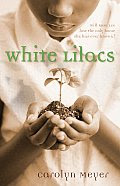
 Meyer, Carolyn. 1993. White Lilacs.
Meyer, Carolyn. 1993. White Lilacs.
In the time before we knew that we would be driven away, our lives uprooted, and our people scattered, Grandfather Jim Williams spent every spare minute tending his beautiful garden in Freedomtown. He loved that garden, and I loved him. The garden was my favorite place.
Set in the fictional town of Dillon, Texas, White Lilacs tells the story of a community within a community. Freedomtown, a community of African Americans (Though of course they weren't called that then, negroes or colored being the terminology then. Though Meyer does use the n* word later on when relations become more strained.) Our narrator is Rose Lee Jefferson, a twelve year old who is about to forced into growing up rather quickly. She is a girl that loves life, loves her family, loves to draw. She especially loves spending time with her grandfather. He is a gardener for the Bell family. Her Aunt Tillie works for the Bell family as well. (I believe as the cook.) One day, soon after our narrative opens, Rose is unexpectedly called into the Bell's kitchen by her aunt and told that she needs her to serve luncheon to the Bells and their guests. She had been having fun with her grandfather, and the garden was a place she felt at home, felt comfortable. But she does what she must. It's a day that will change her life forever. Why? She overhears that the white folks of the community are planning to force them out, force them to sell. They want a park, a library, a woman's club. Throughout that summer, Rose works when she can and overhears as much as she dares. But by the middle of July, it's clear that the whites will have their way. Change is a coming. And coming fast. Knowing that it would be impossible to save their community, Rose acts quickly to preserve what she can--on paper. She draws what she can--the school, the churches, the homes, the businesses.
Throughout that summer, Rose works when she can and overhears as much as she dares. But by the middle of July, it's clear that the whites will have their way. Change is a coming. And coming fast. Knowing that it would be impossible to save their community, Rose acts quickly to preserve what she can--on paper. She draws what she can--the school, the churches, the homes, the businesses.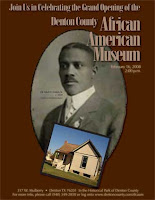 White Lilacs is a heartbreaking story of prejudice and hate. But it is also a story of a loving family, a family that holds onto hope, holds onto the good, that holds together.
White Lilacs is a heartbreaking story of prejudice and hate. But it is also a story of a loving family, a family that holds onto hope, holds onto the good, that holds together.
Though fictional in nature, the book tells the all-too-real story of Quakertown in Denton, Texas. In the early 1920s, the African Americans of Quakertown were forced to sell their land so that the white folks of the city could have a park. You can read more about the actual Quakertown here and here. You can even watch a mini-documentary about it here. There is now a museum opened that tells the story of the community and documents Denton's shameful past.
Blog: Becky's Book Reviews (Login to Add to MyJacketFlap)
JacketFlap tags: J Historical Fiction, Young Adult Challenge, Young Readers Challenge, A ~ Z Reading Challenge, by the decades challenge, first in a series challenge, Add a tag
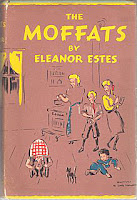
 Estes, Eleanor. 1941. The Moffats.
Estes, Eleanor. 1941. The Moffats.
The Moffats may not be the most exciting, thrilling, page-turning book I've ever read, but it is enjoyable none the less in its quiet, subtle, gentle way. The book focuses on the Moffat family. A mother raising her kids alone. The family is not rich--as you can imagine--but there is a loving, caring atmosphere that makes for a very happy home. The book is episodic. The narrator or main character changes from chapter to chapter. And there is no one connecting plot that threads them altogether. (Well, maybe that isn't quite true. If there is such a plot it would be that their landlord has put their house up for sale. This occurs in the first or second chapter. And the house is sold and the Moffats have to move in the last chapter.) Each chapter is a story of sorts about what life is like--daily life around the house, around school, around town, etc. The stories are mostly lighthearted and fun. But there are some serious moments as well, some moments that border on being a lesson in morality. For readers looking for family-oriented, family-friending reading material, The Moffats is sure to satisfy.
First sentences: The way Mama could peel apples! A few turns of the knife and there the apple was, all skinned! Jane could not take her eyes from her mother's hands. They had a way of doing things, peeling apples, sprinkling salt, counting pennies, that fascinated her.
224 pages
Blog: Becky's Book Reviews (Login to Add to MyJacketFlap)
JacketFlap tags: family, school, J Fiction, A ~ Z Reading Challenge, by the decades challenge, Add a tag
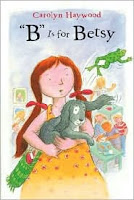
 Haywood, Carolyn. 1939. B is for Betsy.
Haywood, Carolyn. 1939. B is for Betsy.
I'll keep this one short and sweet. I read this book because I've been going way way back this month. (Who knows why???) Anyway, as far as books from the thirties go, this one is charming enough. The heroine is, of course, named Betsy. And the plot is episodic. Each chapter is a new adventure. Most of them center around life at home and life at school. It's not that the book is bad, it's just a bit dated. You can love it, I hope, and still admit that it's dated. (If you grew up with this book and loved it and want to share it with your kids, I don't want to offend you by saying it's "dated." But as an adult reader I've got to be honest and say that I'm not so sure that today's young readers are going to be as charmed with it as their grandmothers may have been. You may pull it off if you do it as a read aloud, but I don't know that a kid would pick this one up on their own and stick with it. Not without some motivation or guidance or exuberance from a trusted adult.)
First sentence: "Betsy lay in her little white bed. She had been awake a long time. Outside her window the birds were calling "Good Morning" to each other, but Betsy did not hear them. All summer long she had jumped out of bed as soon as her eyes were open. She had always run to the window and thrown sunflower seeds out to the birds for their breakfast. But this morning Betsy was so busy feeling unhappy that she forgot all about the birds. Betsy was unhappy because today was the first day of school. She had never been to school and she was sure she would not like it."
159 pages.
Blog: Becky's Book Reviews (Login to Add to MyJacketFlap)
JacketFlap tags: school, J Fiction, J Fantasy, A ~ Z Reading Challenge, dysfunctional families, by the decades challenge, Add a tag
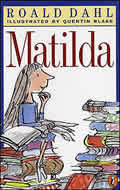
 Dahl, Roald. 1988. Matilda.
Dahl, Roald. 1988. Matilda.
I read this one because I was inspired by Melissa. What can I say about it? It's wild. It's definitely out there. But it's fun. Oodles and oodles of fun. Realistic? Never in a million years. Was it meant to be? Of course not. A zany (how often do I use that word???) over-the-top thoroughly enjoyable read. Matilda is a young genius. (4 or 5 years old) An under appreciated genius at that. Her parents are ghastly. There really isn't any other way to say it. They're abominable. So Matilda has a way of getting back at her parents for their cruel and horrid behavior. Then it's time for Matilda to start school. She's got a good teacher--a teacher that is practically a saint--but the superintendent (my guess is the equivalent of a principal) is evil incarnate. The battle between good and evil has never been quite so strange. Anyway, it's a fun read. But as I said, it probably isn't for everyone.
It's a funny thing about mothers and fathers. Even when their own child is the most disgusting little blister you could ever imagine, they still think that he or she is wonderful. Some parents go further. They become so blinded by adoration they manage to convince themselves their child has qualities of genius. Well, there is nothing very wrong with all this. It's the way of the world. It is only when the parents begin telling us about the brilliance of their own revolting offspring, that we start shouting, "Bring us a basin! We're going to be sick!"
240 pages.
Blog: Becky's Book Reviews (Login to Add to MyJacketFlap)
JacketFlap tags: classic, romance reading challenge, Nineteenth Century Women Writers' Challenge, Chunkster Challenge, by the decades challenge, 888 Challenge, Add a tag
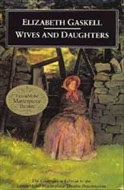
 Gaskell, Elizabeth. 1866. Wives and Daughters.
Gaskell, Elizabeth. 1866. Wives and Daughters.
To begin with the old rigmarole of childhood. In a country there was a shire, and in that shire there was a town, and in that town there was a house, and in that house there was a room, and in that room there was a bed, and in that bed there lay a little girl; wide awake and longing to get up, but not daring to do so for fear of the unseen power in the next room; a certain Betty, whose slumbers must not be disturbed until six o'clock struck, when she wakened of herself 'as sure as clockwork' and left the household very little peace afterwards. It was a June morning, and early as it was, the room was full of sunny warmth and light.
This first chapter introduces us to a young Molly Gibson. She's around twelve at the time give or take a little. And she is most eager to go to her 'first' 'real' social event: a tea hosted by the Lord and Lady of the region--Lord and Lady Cumnor. The Cumnor's estate--they have several--in the region was called The Towers. (Usually they reside elsewhere. This is definitely just their country vacation home.) At this grand party, the young girl gets bored wanders into the gardens, falls asleep, is later discovered by the former-governess-then widow, Mrs. Kirkpatrick. (The family STILL calls her Miss Clare.) This discovery ruins the day for her. It's not that the family treats her poorly, it's just that when Mrs. Kirkpatrick tells the young girl to rest from being out in the sun (or some such notion) in her room, the girl falls asleep and misses her ride home. So she awakens hours later alone and confused and wanting to go home and be with her dad. (Her mother died when she was just a wee thing.) Her dad, the doctor, a somewhat dignified, genuinely respected doctor, comes to her rescue, however, and she's saved the embarrassment of having to sleep over.
A few chapters later Molly has grown from twelve to sixteen. She's becoming a young lady, an attractive young lady. And her father is noticing the transition. Feeling overwhelmed by the thought of raising her alone, he decides to remarry. It's not that he decides this overnight. At first he resists the notion. But as the idea sits with him, it grows on him more and more. When he discovers that Mrs. Kirkpatrick is once again visiting The Towers (after quite a few years absence from the region) he decides to call on the family and see if she might not do as a wife. He knows or vaguely remembers that she has a daughter around Molly's age. He hopes that the idea of raising a daughter without a father will seem equally daunting to her as raising a daughter without a mother.
Molly is SO NOT HAPPY with the idea of a stepmother and stepsister.
And here my summary must stop. The book is long 648 pages. But it is good in a steady kind of way. It is slow; It is steady; It is good; It improves with each bit. (What do I mean by "bit"? Well, the descriptions seem heavy and largely unnecessary--very weighty--at the very beginning. But towards the middle and especially at the end, it begins to make sense. These descriptive bits which you take for fluff at first, are meant to pad the resulting pages. In other words, they help explain or fill out or give substance to the rest. It's not that you'll desperately need that information, but it will make more sense and be a better read if you resist the urge to skip and skim. Gaskell has a HUGE task. She brings to life a whole community. From the Gibsons to the Kirkpatricks to the Cumnors to the Hamleys to the town busybodies. A real panoramic, sweeping view or portrait of life.
Blog: Becky's Book Reviews (Login to Add to MyJacketFlap)
JacketFlap tags: J Historical Fiction, J Fiction, Celebrate the Author Challenge, by the decades challenge, Heart of a Child Challenge, Add a tag
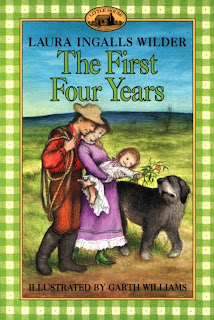

Wilder, Laura Ingalls. 1971. The First Four Years.
The stars hung luminous and low over the prairie.
The First Four Years was published several decades after the death of Laura Ingalls Wilder. It was published after the death of Laura and Almanzo's daughter, Rose Wilder Lane. It is based on three hand-written notebooks. The story is believed to have been written in the mid to late forties. It is also believed to have been shelved by Laura Ingalls Wilder after the death of Almanzo. She never went back to work on it again. She never polished it up. She never sent it to the publishers. It is what it is, a first draft.
It has a completely different feel than the other Little House books. It doesn't have chapters, for one thing. But more than that there is an emotional undertone of sadness and regret that makes it pointedly different than its predecessors. It is just very melancholy. Yes, it captures all the horrible things that happened next. Yes, it's probably accurate enough to assume that most if not all farmers experienced this many brutal hardships. The other Little House books often dealt with hard issues as well. But I suppose they felt more balanced. I think she injected enough hope and light to lift them up.
Personally, I'd rather have the "happily ever after" ending of These Happy Golden Years than the brutal hardships of The First Four Years. Not that I'm promoting the unrealistic fairy-tale ending where marriage is problem-free. But to read of all the hardships with the farm, the land, the money problems, the debt, the worries, the health problems, the weather/environment problems, etc. It's just so hard, so brutal, so depressing.
134 pages.
Blog: Becky's Book Reviews (Login to Add to MyJacketFlap)
JacketFlap tags: J Historical Fiction, J Fiction, Celebrate the Author Challenge, Young Readers Challenge, by the decades challenge, 888 Challenge, Heart of a Child Challenge, Add a tag
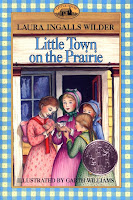
 Wilder, Laura Ingalls. 1941. Little Town on the Prairie.
Wilder, Laura Ingalls. 1941. Little Town on the Prairie.
I'm not sure how other fans feel. I've never sat down to have deep philosophical discussions on which books from the series are their personal favorites and bests. But Little Town on the Prairie gets my pick for being an unsung hero. I always, always forget about it when naming my favorites. It gets overshadowed by The Long Winter and These Happy Golden Years. But I would imagine that each and every time I sit down to actually read it, I find myself delighted and surprised.
The book opens almost where Long Winter left off. The Ingalls family have moved back to their homestead. They are living in their claim shanty. They are busy, busy, busy. It seems each book finds them always hard at work, always diligent, always thinking ahead and planning. What is on their minds in this book is getting enough money saved to send Mary to college. Her school for the blind. At the heart of this is Laura's determination to earn money to contribute to the family's savings. At first this is through her work in town helping the seamstress. But it is also in her quiet, steady determination to study hard so that she can earn her teacher's certificate when she is sixteen.
What is so delightful about Little Town on the Prairie is the quiet, peaceful winter spent in town. Here we see Laura attending school on a regular basis. Here we see her making friends. Here we see a return of Nellie Oleson. No longer the "city girl" or the "town girl." Nellie is now the shabbier, poorer neighbor. She's as mean as ever. Or so Laura would have us belief. A nice Nelly? Unthinkable! But above all, Little Town on the Prairie is delightful because of Almanzo Wilder.
"Name Cards" is one of my favorite chapters. It starts out with Nellie being horrid, and ends with a rather subtly romantic first ride for Laura behind Almanzo's oh-so-admired horses. (Laura has been eying those horses for quite a while now.) Almanzo sees her hurrying along to school--worried she might be late--and so he offers to give her a ride. She didn't know he knew she existed. Anyway, pure delight.
Of equal delight is "Schooltime Begins Again" where Almanzo Wilder asks Laura Ingalls if he can walk her home after the revival. The revival lasts all week, and each night he is there by her side waiting to ask to see her home. Around this time, though not quite in this chapter, he asks if she would like to go for sleigh rides in January when his new cutter is finished.
Small beginnings that won't come to bloom until These Happy Golden Years. But beginnings that make you smile and are satisfying in their own way.
First sentence: One evening at supper, Pa asked, "How would you like to work in town, Laura?" Laura could not say a word. Neither could any of the others.
Pages: 307
Blog: Becky's Book Reviews (Login to Add to MyJacketFlap)
JacketFlap tags: J Historical Fiction, J Fiction, Jewish, Jewish Literature Challenge, A ~ Z Reading Challenge, by the decades challenge, Add a tag
 Taylor, Sydney. 1951. All Of A Kind Family.
Taylor, Sydney. 1951. All Of A Kind Family.
Originally published in 1951, Sydney Taylor's novel, All of A Kind Family, is set in New York City around 1912. The family consists of a mom, a dad, and five "step and stair" daughters. (They range in age from twelve to four.) The book is about the adventures the five sisters have together. It's definitely not your typical book if you're judging it by modern standards. There is less plot, for one thing, but the charm--or part of the charm--is in the individual stories, the episodes. The fact that it is more a compilation of loosely connected stories masquerading as a novel isn't a problem in my opinion. (But I'm curious what modern children would make of it all???)
The book does have its charms. There's no doubt about that. And one of the things I do like about the book is the fact that it highlights so many different aspects of being Jewish. For example, I haven't come across too many fiction novels (or picture books for that matter) that show families celebrating Purim and Succos. (These aren't the only celebrations by any means.) It was just interesting to see these aspects of culture and religion interwoven with the typical and traditional threads of family life and social life--going to school, going to the library, going to the beach, going shopping, getting a new baby, etc.
Part of me is curious as to how modern readers would respond to this novel and others like it. Would it be considered too old fashioned? Too dated? Too boring? While I can appreciate it the novel as an adult, I'm not sure what I would have thought of it as a child.
For example, the chapter that is really "out there" for me is how the mother tricks the children into doing housework. The chapter is called "Dusting is Fun." And it doesn't matter if you're 8 or 9 or 29, you KNOW that that sentence is a lie and always will be a lie. The mother successfully tricks her five children into playing a game "find the buttons while you dust" to get them to do their least favorite chore each week. I don't buy it. It's not like finding a button is a great reward. It's not like they get to keep the button. It's not like they can trade the buttons for a penny or two to keep. They're just finding the same buttons over and over again each week and making it an-ever-so-fun game. I just don't buy it at all.
However, the rest of the chapters do work for me for the most part.
First sentence: "That slowpoke Sarah!" Henny cried. "She's making us late!" Mama's girls were going to the library, and Henny was impatient.
It is 189 pages.
Blog: Becky's Book Reviews (Login to Add to MyJacketFlap)
JacketFlap tags: J Historical Fiction, J Fiction, Celebrate the Author Challenge, A ~ Z Reading Challenge, by the decades challenge, Add a tag

Wilder, Laura Ingalls. 1939. By the Shores of Silver Lake. Laura was washing the dishes one morning when old Jack, lying in the sunshine on the doorstep, growled to tell her that someone was coming. She looked out, and saw a buggy crossing the gravelly ford of Plum Creek. "Ma," she said, "it's a strange woman coming."
Laura was washing the dishes one morning when old Jack, lying in the sunshine on the doorstep, growled to tell her that someone was coming. She looked out, and saw a buggy crossing the gravelly ford of Plum Creek. "Ma," she said, "it's a strange woman coming."
There is a somewhat large gap between On the Banks of Plum Creek and By the Shores of Silver Lake. We last saw Laura at age 8 or possibly 9. In the beginning of By the Shores of Silver Lake, she is thirteen. And the book's action begins after some melancholy life-altering drama: four of the family had had scarlet fever: Mary, Carrie, Grace, and Ma. (Grace appears with no introduction.) This scarlet fever has left Mary blind.
This "strange woman" is a friend and relation. She is Laura's Aunt Docia. She is there to present Pa with a job offer. Her husband works for the railroad, and she thinks Pa should work for them too. He accepts. But it is decided that he should go alone. Mary isn't ready to travel yet. And the family can go most of the way by train. But it is at this point that we are forced to say goodbye to one of the most beloved fictional dogs of all time, Jack. Jack dies on the eve of Pa going West again.
The novel takes the Ingalls family into South Dakota around DeSmet where the rest of the series is set.
It's not that I don't like this novel. Although I don't. Not really. It's just that in comparison to the other novels (especially On the Banks of Plum Creek and The Long Winter) this one doesn't quite do it for me. I'll be honest. I know Jack was old. I know dogs can't live forever. And I know this is historical fiction based on a true story. Still, my childish self can't quite forgive this book for the death of the dog.
By the Shores of Silver Lake is one of five Newbery Honors that Laura Ingalls Wilder received for her historical fiction "Little House" series. (For those that are curious: 1938 for On the Banks of Plum Creek; 1940 for By the Shores of Silver Lake; 1941 for The Long Winter; 1942 for Little Town on the Prairie; 1944 for These Happy Golden Years).
290 pages.
Blog: Becky's Book Reviews (Login to Add to MyJacketFlap)
JacketFlap tags: J Historical Fiction, J Fiction, Celebrate the Author Challenge, series challenge, A ~ Z Reading Challenge, by the decades challenge, 888 Challenge, Heart of a Child Challenge, Add a tag
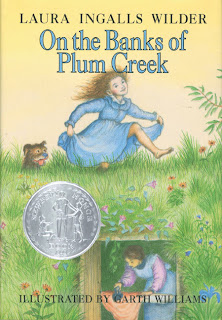
Wilder, Laura Ingalls. 1937. On the Banks of Plum Creek.
The dim wagon track went no farther on the prairie, and Pa stopped the horses. When the wagon wheels stopped turning, Jack dropped down in the shade between them. His belly sank on the grass and his front legs stretched out. His nose fitted in the furry hollow. All of him rested, except his ears.
On The Bank of Plum Creek opens when the Ingalls family arrives at their new home. They have bought a place, and their first new "home" is a dugout. They are buying it from a Norwegian man, Mr. Hanson, who is moving further west I presume. This is just temporary. Charles (or "Pa" as he's referred to so often it's hard not to join in) has promised to build them a real house, a real home just as soon as he can. The book opens with promises and hopes and dreams. But most of the book will see those hopes and dreams delayed. What Pa needs--what they all need--are good crops, good wheat crops. What Pa gets is grasshoppers. The Ingalls family does struggle a bit in On The Banks of Plum Creek. But they do settle in and get comfortable. Mary and Laura, for instance, start school. It is the first time for them to ever attend school. And they do meet up with some town folks like Nellie Oleson.
Overall, this is a more than enjoyable read. Some of my favorite chapters are "Nellie Oleson," "Town Party," "Country Party," "Going to Church," and "Surprise."
It is 339 pages.
Blog: Becky's Book Reviews (Login to Add to MyJacketFlap)
JacketFlap tags: J Historical Fiction, J Fiction, A ~ Z Reading Challenge, by the decades challenge, Young Adult Reading Challenge (Shady Glade), Add a tag
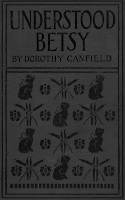
Fisher, Dorothy Canfield. 1917. Understood Betsy.
When this story begins, Elizabeth Ann, who is the heroine of it, was a little girl of nine, who lived with her Great-aunt Harriet in a medium-sized city in a medium-sized state in the middle of this country; and that's all you need to know about the place, for it's not the important thing in the story; and anyhow you know all about it because it was probably very much like the place you live in yourself.
Elizabeth Ann is an orphan raised by her great-aunt Harriet and her aunt Frances. The first chapter shows the reader just how life as she knew it was for Elizabeth Ann. To say she was coddled would be a bit of an understatement. To say that both aunts and niece were a bit psychologically unsound would be a bit closer to the truth. It's not that they're crazy crazy. It's just that they're anxious, jittery, nervous, worrisome, panicky, fidgety, chicken-little-y type people. They're sweet and docile enough, but they lack gumption and ingenuity and vitality.
Understood Betsy is the story of how Elizabeth Ann transforms into Betsy. It all starts when one of her caretakers gets diagnosed with an unnamed disease. (If they named it, I sure missed it. But I think the main point was to get the two aunts out of the picture.) Elizabeth Ann is sent to live with the other side of the family. Her aunt (Abigail) and uncle (Henry) and first cousin (Ann). They live in Vermont, I believe.
From the very beginning, Elizabeth Ann knew that she was entering the unknown. On her way to her new home--in the buggy--she has her first enlightened moment. "It is possible that what stirred inside her head at that moment was her brain, waking up. She was nine years old, and she was in the third-A grade at school, but that was the very first time she had ever had a whole thought of her very own." (21)
Her awakening, her transformation is entertaining enough and the descriptions of life and family are charming as well. I think some readers will love Betsy, understand Betsy; but I'd be silly if I didn't acknowledge the fact that some readers would find Understood Betsy to be boring or quaint. Anyway, long story short...I loved it. I thought it was great. If I had discovered this as a child--like my mother did and most likely my grandmother did--I'm sure I would have loved it. I'm sure I would have read it over and over again.
You can find the entire book--including illustrations--online.
Blog: Becky's Book Reviews (Login to Add to MyJacketFlap)
JacketFlap tags: J Historical Fiction, J Fiction, Young Readers Challenge, A ~ Z Reading Challenge, by the decades challenge, Add a tag
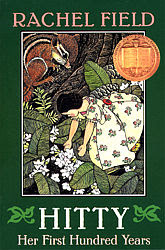
Field, Rachel. 1929. Hitty: Her First Hundred Years.
The antique shop is very still now. Theobold and I have it all to ourselves, for the cuckoo clock was sold day before yesterday and Theobold has been so industrious of late there are no more mice to venture out from behind the woodwork. Theobold is the shop cat--the only thing in it is that is not for sale, which has made him rather overbearing at times. Not that I wish to be critical of him. We all have our little infirmaties and if it had not been for his I might not now be writing my memoirs. Still, infirmities are one thing, and claws are another, as I have reason to know.
Hitty, Her First Hundred Years won the Newbery award in 1930. Who is Hitty? Hitty is a doll. A wooden doll made from the ever-lucky mountain-ash wood. Her story begins when an Old Peddler--old peddlers are so rarely named in books--takes refuge with a family in Maine. Mrs. Preble is awaiting the return of her husband--who is a whaler--and she has the children to care for. One of her children is a young girl named Phoebe. (The other is a boy named Andy.) The Peddler takes refuge in the storm, but ends up staying quite a while with the family. At some point during his visit, he carves this doll--soon named Mehitabel--for the little girl. Phoebe's told she must sew clothes for the doll before she can be played with--and one of the items Phoebe makes is an undergarment--a chemise--with "Hitty" cross-stitched on it.
Hitty's adventures span the globe and span generations. Sometimes her change of locale is purposeful--when the Preble family takes her on a ship's voyage to the South Seas--and other times it is quite accidental--when Phoebe drops the doll in India and she is "discovered" by a wandering snake charmer. She has many different owners; she has many different adventures. Throughout it all, she tries to hold on to as much grace and dignity as she can. Which isn't always easy. (Like when she's made an idol in the South Seas.)
The book is illustrated by Dorothy P. Lathrop. The illustrations are black and white. And they are very likely the original illustrations for the book. Original art is important I know to preserving the feel of a book at times. (Like I would be monstrously upset if someone removed Garth Williams illustrations from the Little House books. Oh wait, somebody did. And it was wrong, wrong, wrong.) But when I see beautiful new editions of The Wind in the Willows or Alice in Wonderland or The Secret Garden. Editions with incredible illustrations. I can't help but wishing that Hitty will one day get the same treatment. My choice? Bagram Ibatoulline.
When I was reading The Miraculous Journey of Edward Tulane, I thought. I bet this book must be like Hitty. I'd never read Hitty. It was just a hunch. An educated guess. A guess that turned out to be all too accurate. Hitty didn't start out unloved, mind you, and she was never nailed to a stake and used as a scarecrow. However, she did spend decades folded up in a horsehair sofa in an attic. The similarities are interesting.
Hitty, Her First Hundred Years was a good read for me. I enjoyed it. I thought it was charming in some places. Interesting in others. There were just a few sentences here and there that might be jarring to the modern reader. For example, early on in her life--turn of the nineteenth century--Hitty refers to Native Americans as 'Injuns'. Phoebe and Andy are out picking blackberries or blueberries or some sort of berry. They wander too far away and see Indians in the distance. Both get so frightened that they run away. In the chaos--the Indians never saw them or chased them--Phoebe drops her doll and later worries that the 'Injuns' might have taken her. And a few chapters later, when the Preble family is sailing--in a whaling ship--the South Seas. A storm leaves them stranded on an island with "savages."
Blog: Becky's Book Reviews (Login to Add to MyJacketFlap)
JacketFlap tags: science fiction, series challenge, sci-fi experience 2008, by the decades challenge, Add a tag
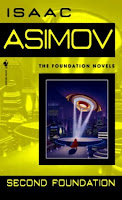
So I finished the third book in the original Foundation trilogy. (The other two being Foundation and Foundation and Empire.) Of the three, I must admit a strong preference for the middle novel. There is something magical that just works about Foundation and Empire. But that's not to say that Foundation and Second Foundation weren't enjoyable enough reads.
What can I say about Second Foundation? Well, it was originally published in novel form in 1953. It had previously been published as two separate short stories in 1948 and 1949. If memory serves me, around four hundred years have elapsed since the opening of Foundation. (It *might* be three hundred or five hundred. But my gut is saying four.) The stories share a theme--a strong theme. While all of the novels--the stories--have shared the theme of preservation and ambition, Second Foundation expands on that theme. This novel is all about the quest.
In the first story, those doing the questing are The Mule and the Mule's men. Han Pritcher, a character first introduced in Foundation and Empire, is one of the main characters. Bail Channis is a new character. He plays a rather large role in the story. These two have been paired together by The Mule to go on a quest--a search--for the Second Foundation. Their goal? To find out where it is so The Mule can finish his conquest of the Galaxy and rule supreme over all. Ambitious? Definitely! Doomed to fail? Probably. But the two have been given the mission without the option of saying no.
In the second story, those doing the questing are the descendants of Bayta and Toran Darell. Their son, Toran, and granddaughter, Arcadia, unknowingly hold the fate of the Second Foundation in their hands. Arcadia (or Arkady as she likes to be called) is only a teen--14 to be exact--but she is determined to have her chance for glory--her chance to be a hero. Her idol? Her grandmother who helped take down The Mule. Arcadia's quest? To be the one to find the Second Foundation. Her goal to help the Foundation destroy the Second Foundation. She's definitely an original, spunky kind of heroine. Very opinionated. Very determined. But can it be down? Can one person single-handedly do the seemingly impossible?
Blog: Becky's Book Reviews (Login to Add to MyJacketFlap)
JacketFlap tags: classic, Jane Austen mini-challenge, Nineteenth Century Women Writers' Challenge, A ~ Z Reading Challenge, by the decades challenge, 888 Challenge, Add a tag

How do I love thee? Let me count the ways....
Persuasion by Jane Austen has to be--without a doubt--my favorite, favorite Austen novel. I've only read it twice, but each time was oh-so-magical. Though I will *admit* that it perhaps isn't a book that will "grab" you from page one. It might take some patience and effort, but give it a chapter or two (or three) and you might just find yourself swept up in the story of Anne Elliot.
Sir Walter Eliott, of Kellynch-hall, in Somersetshire, was a man who, for his own amusement, never took up any book but the Barnetage; there he found occupation for an idle hour, and consolation in a distressed one; there his faculties were roused into admiration and respect, by contemplating the limited remnant of the earliest patents; there any unwelcome sensations, arising from domestic affairs, changed naturally into pity and contempt, as he turned over the almost endless creations of the last century--and there, if every other leaf were powerless, he could read his own history with an interest which never failed--this was the page at which the favorite volume always opened: Elliot of Kellynch-Hall.
See what I mean about NOT being an opening that will hook you? Long story short...or three reasons why you should read Persuasion despite its verbose, pompous opening....
1) It is the story of Anne Elliot. A middle child, a daughter obviously, born into a pompous and atrocious family muddles through the best she can while waiting for her Prince to come. (Okay, she's not really waiting for her Prince to come and rescue her. She's all but given up on love since she's also, at age 27, an "old maid.")
2) Despite coming from a ghastly, horribly obnoxious family, Anne herself is not only intelligent and genuine but she's also thoroughly enjoyable and likable. She has a wit and cleverness about her. She actually sees the world around her. She isn't blind to reality like so many of the other characters.
3) Persuasion is all about second chances. Anne Elliot, a girl who truly deserves good things because her family is so rotten, lost her one chance for love and happiness eight years before our narrative opens. Her heart belonged--then and now--to a young man, a sailor, Frederick Wentworth. But her family and friends deemed him unworthy and unacceptable. And forced into choosing between her family and her love, she chose her family. A decision she regretted from the moment she broke her lover's heart.
When Persuasion opens the reader learns that hard times have come to the Elliot family--a family mostly known for its arrogance and pride. The family is *forced* into renting their out their estate to an Admiral Croft and his wife. The Elliot family--all but Anne--will reside in Bath year round. Anne, poor Anne, only Anne, will be parceled out as need be between Bath and her father and older sister, Elizabeth, and her younger sister, Mary.
What can I say about Mary? Mary is interesting--and by interesting I mean obnoxious and annoying--in a completely different way than her father, Sir Walter, and her sister, Elizabeth. Mary is married to Charles. Charles Musgrove. Charles and Mary and their two children live on the estate--in a smaller house--as his parents and his sisters. They live in the "great house." Anne's time spent with her sister and her sister's in-laws is interesting to say the least. Mainly because someone has just arrived in the neighborhood. A Captain Wentworth. Captain Frederick Wentworth.
Just the sight of him makes her heart skip a beat--or two or three--she loves him like she's always loved him. But he's out of reach. He's now courting--of all people--one of the Musgrove sisters.
Love. Requited. Unrequited. Broken hearts. Regret. Jealousy. Disappointment. Frustration. It's all there with just a little more besides.
I do not want to spoil this one for anyone. Really. I don't want to. So please, please, please stop reading if you haven't read the novel. I mean it.
S
P
O
I
L
E
R
There are just a few scenes--one really big scene--that makes this novel oh-so-magical. That takes it from nice to really really great.
I love, love, love the conversation between Anne Elliot and Captain Harville. Their discussion on which sex--which gender--loves most, loves deepest, loves truer is one of the best dialogues ever. Seriously. Mostly because of the heart-felt letter that is the result of Captain Wentworth overhearing that conversation. That letter? The best, most romantic love letter of ALL TIME. Who could not love this guy?
I can listen no longer in silence. I must speak to you by such means as are within my reach. You pierce my soul. I am half agony, half hope. Tell me not that I am too late, that such precious feelings are gone forever. I offer myself to you again with a heart even more your own than when you almost broke it eight years and a half ago. Dare not say that a man forgets sooner than woman, that his love has an earlier death. I have loved none but you. Unjust I may have been, week and resentful I have been, but never inconstant. You alone have brought me to Bath. For you alone I think and plan.
The letter goes on, but I think you get the idea. Anyway, as much as I love Pride & Prejudice (and I do) I've just got to give the award to Anne and Captain Wentworth when it comes to love and romance. Okay, it only wins by a small margin--because Darcy is quite a letter-writer as well. And he is oh-so-dreamy in his own ways. But Anne, Anne is what makes this book so wonderful. She's a heroine that has nothing to recommend her but her self--her true self. A self that only a few recognize as a thing of beauty, a thing of great worth.
Let's compare Wentworths...first the 1995 Persuasion, then the 2008 Persuasion.
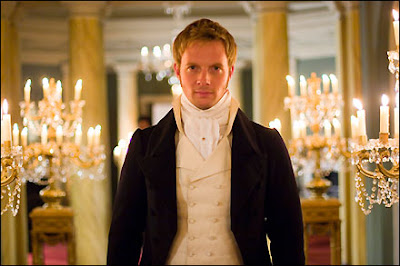
Now let's compare Anne Elliots...first the 1995 Persuasion, then the 2008 Persuasion

There is a cool character chart for the new movie.
As for the movies, I think I will *always* prefer the 1995 version. Even though none of the characters are glamorously beautiful, they're real and genuine. And that movie is *closer* to the book than this latest version. The real crime--in my opinion--is that they DID NOT HAVE the ultra-romantic scene with Captain Harville and Anne Elliot. They abbreviate that conversation down to a few lines, put it very nearly in the beginning, and have it taking place between Anne and a Captain Benwick. Therefore Wentworth can't overhear it, and doesn't have the *proper* motivation to write that beautiful, beautiful letter. Instead they invent a new excuse or else completely gloss over motivation entirely and have the letter showing up without provocation or reason. It's just suddenly there in the script. Silly, silly writers. Why mess with the majesty of the perfect scene???? If the new movie HAD bothered to get it right, perhaps there would be some competition between the two.
Blog: Becky's Book Reviews (Login to Add to MyJacketFlap)
JacketFlap tags: science fiction, Cardathon Challenge, series challenge, sci-fi experience 2008, by the decades challenge, Add a tag

Foundation and Empire by Isaac Asimov was originally the second in a trilogy of novels. First published in 1952, the novel is in fact two stories or two novellas originally published (separately) in 1945.
Things you should know:
*Foundation was good. Really good. But Foundation and Empire was even better.
*Foundation and Empire is infinitely better than Prelude to Foundation.
*While I would certainly recommend reading Foundation, I think you could pick up Foundation and Empire without having read the other and still appreciate it for the great book that it is. It does in fact include a nice two page summary of the novel Foundation.
*Foundation and Empire has a certain something-special about it that makes it stand apart from Foundation. The writing seems wittier, funnier, more tongue-in-cheek. There's just something about it that makes it pop.
I am still operating under the philosophy of sometimes it is better not to know, BUT at the same time I don't want to be accused of not "reviewing" it properly.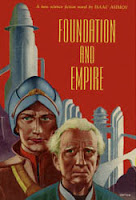 Foundation and Empire roughly picks up about three hundred years after Foundation opens. In the first novella, "The General" the reader learns of the fourth (I believe it's fourth) Seldon crisis. One of the strongest generals of the Empire (what remains of the Empire) is out to destroy the Foundation. Bel Riose is the general's name. Ducem Barr, the son of a man we met briefly in Foundation, is a main character--a character that opposes the Empire even at great risk to his own life and his own family. Lathan Devers, a trader, is also of importance. The plot of "The General" is relatively simple, and this is the shorter of the two stories. In the second novella, "The Mule" the Foundation faces its GREATEST threat so far. It begins simply with the homecoming of a bride and groom. Bayta and Toran. They're visiting Toran's family on the planet of Haven. Haven is a "rat hole" of a planet where traders--mostly retired traders--go to hide out and evade paying taxes to the Foundation. The planet is technically a part of the Foundation. But they're more of a rebellious bunch on Haven. The reader soon learns that not everyone thinks Foundation is perfect when it comes to running the galaxy--or their small part of the galaxy. There is discontent among the ranks of citizens. But even the threat--the small threat--of civil war pales in comparison to the REAL threat of The Mule. I will say no more about the Mule or the rest of the story. I don't care how curious you are! Some things you can't pry out of me.
Foundation and Empire roughly picks up about three hundred years after Foundation opens. In the first novella, "The General" the reader learns of the fourth (I believe it's fourth) Seldon crisis. One of the strongest generals of the Empire (what remains of the Empire) is out to destroy the Foundation. Bel Riose is the general's name. Ducem Barr, the son of a man we met briefly in Foundation, is a main character--a character that opposes the Empire even at great risk to his own life and his own family. Lathan Devers, a trader, is also of importance. The plot of "The General" is relatively simple, and this is the shorter of the two stories. In the second novella, "The Mule" the Foundation faces its GREATEST threat so far. It begins simply with the homecoming of a bride and groom. Bayta and Toran. They're visiting Toran's family on the planet of Haven. Haven is a "rat hole" of a planet where traders--mostly retired traders--go to hide out and evade paying taxes to the Foundation. The planet is technically a part of the Foundation. But they're more of a rebellious bunch on Haven. The reader soon learns that not everyone thinks Foundation is perfect when it comes to running the galaxy--or their small part of the galaxy. There is discontent among the ranks of citizens. But even the threat--the small threat--of civil war pales in comparison to the REAL threat of The Mule. I will say no more about the Mule or the rest of the story. I don't care how curious you are! Some things you can't pry out of me.
Blog: Becky's Book Reviews (Login to Add to MyJacketFlap)
JacketFlap tags: science fiction, Cardathon Challenge, Speculative Fiction Challenge, series challenge, sci-fi experience 2008, A ~ Z Reading Challenge, Short Story Reading Challenge, by the decades challenge, Add a tag
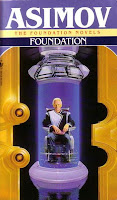
Some books feel like friends from the very beginning. Such is the case with Isaac Asimov's novel, Foundation. This book was originally the first in a series of Foundation novels. (However, Prelude to Foundation has since been published.) The novel is composed of five sections. Four of these sections were originally published separately and appeared as short stories in Astounding Magazine between 1942 and 1944. They were later compiled together into one volume in 1951 alongside a newly written introduction section, and thus Foundation as we know now it was published. (Does any of that matter? Not really. I didn't read the details on the publishing history until after I read it. But as an after note, I was intrigued by it. So I thought I'd share it with you.)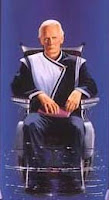 For twelve thousand years the Galactic Empire had ruled supreme. Now it was dying. But only Hari Seldon, creator of the revolutionary science of psychohistory, could see into the future--a dark age of ignorance, barbarism, and warfare that would last thirty thousand years. To preserve knowledge and save mankind, Seldon gathered the best minds in the Empire--both scientists and scholars--and brought them to a bleak planet at the edge of the Galaxy to serve as a beacon of hope for future generations. He called his sanctuary the Foundation.
For twelve thousand years the Galactic Empire had ruled supreme. Now it was dying. But only Hari Seldon, creator of the revolutionary science of psychohistory, could see into the future--a dark age of ignorance, barbarism, and warfare that would last thirty thousand years. To preserve knowledge and save mankind, Seldon gathered the best minds in the Empire--both scientists and scholars--and brought them to a bleak planet at the edge of the Galaxy to serve as a beacon of hope for future generations. He called his sanctuary the Foundation.
But soon the fledgling Foundation found itself at the mercy of corrupt warlords rising in the wake of the receding Empire. Mankind's last best hope was faced with an agonizing choice: Submit to the barbarians and be overrun--or fight them and be destroyed.
What can I say about Foundation without giving too much away? It is one of those rare books where it's best not to know. Best not to have preconceived notions of what it's all about. Best not to think too much about what it's saying and where it's going. It's best to just go along for the ride on this one.
The settings? Various planets. The characters? Too many to list. The plot? Complex but not difficult to follow. Each section of the book is separate from the whole. Most are divided by time. Between sections, thirty years, eighty years, fifty years, a hundred years could have passed. The reader picks up hints here and there about how much time has gone by. But this isn't a book where you follow characters around. This is more of a novel where ideas play the leading role.
If there is a cohesive theme to the novel it is manipulation. Whether passive or aggressive, Foundation is all about power struggles, manipulations, and getting others to do what you want when you want. It is all about ambition.
Do not look at this chart unless you want to confuse yourself. (Or you've read a good many of the books already.) For plot summary of the first novel, click here. For more information on the series as a whole, click here.
Blog: Becky's Book Reviews (Login to Add to MyJacketFlap)
JacketFlap tags: classic, A ~ Z Reading Challenge, Short Story Reading Challenge, by the decades challenge, Add a tag
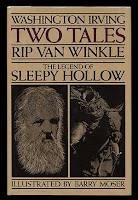
Irving, Washington. Two Tales: Rip Van Wrinkle and The Legend of Sleepy Hollow. Illustrated by Barry Moser.
Perhaps I should be slightly embarrassed to admit this, but this was my first time actually reading both of these stories. My only familiarity with the stories coming through Wishbone in the first instance and a cartoon in the second. (I want to say Disney but I could be wrong.) So why now? Well, I is a difficult letter in the alphabet, AND I was desperate to read a book from the 1820s to complete my loop. Those two aren't great reasons to read a classic, but in all honesty, they were sufficient to motivate me at the library. My impression of the book? Well, I enjoyed them both more than I thought I would. But that isn't necessarily saying much. The language is a bit archaic. Not desperately archaic. But without being *updated* I don't see many kids being able to read it smoothly. Even as a somewhat well-read, somewhat well-educated adult, there were words that in all honesty I had NO idea what they meant. And I would assume that like most readers, I was just too lazy to get up and get a dictionary so I just skimmed over them like they weren't even there. (To my credit, 11 at night isn't the best time to get up and go in search of a dictionary.) But I got the *main* ideas of both stories.
My impression of the book? Well, I enjoyed them both more than I thought I would. But that isn't necessarily saying much. The language is a bit archaic. Not desperately archaic. But without being *updated* I don't see many kids being able to read it smoothly. Even as a somewhat well-read, somewhat well-educated adult, there were words that in all honesty I had NO idea what they meant. And I would assume that like most readers, I was just too lazy to get up and get a dictionary so I just skimmed over them like they weren't even there. (To my credit, 11 at night isn't the best time to get up and go in search of a dictionary.) But I got the *main* ideas of both stories.
The first being a tale of a lazy man with a nagging wife falls into a magical sleep that does him not much practical good but at least rids him of his wife. I can't help but feel for the wife. ANY woman would get annoyed with a man who was THAT lazy and irresponsible. And doubly annoyed that he could at times be helpful to other families, other women, but ignored his own. So this tale doesn't really have a *moral* per se that would prove beneficial. Rip Van Wrinkle was lazy; he was happy to be lazy; he taught his son to be lazy; he liked being waited on hand and foot and the magical sleep just made that happen without the nagging.
The second being a tale of a rather comical school teacher, Ichabod Crane. Ichabod was a school teacher, a singing teacher, and a rather unsuccessful wooer. He wanted to win the heart of a lovely lady. But his competition was, well, the competition got the best of him in the end. Brom Bones. Practical joker extraordinaire. It was an entertaining story about a man who let himself be *scared* out of what he wanted. Can I blame him? Not really. Being chased by a "headless" man and then having aforementioned head tossed at him....would scare me out of town as well.
Overall, both stories were okay. But the artwork of Barry Moser just didn't do much for me. It seemed to date the book. It was originally published in 1984, and the book just looks and feels and smells dated. But in its defense, it was on the shelves while the newer versions of both tales (with better illustrations perhaps) were not. So it served its purpose.
Blog: Becky's Book Reviews (Login to Add to MyJacketFlap)
JacketFlap tags: adult fiction, humor, classic, Cardathon Challenge, A ~ Z Reading Challenge, by the decades challenge, Add a tag

The Diaries of Adam & Eve Translated by Mark Twain. Illustrated by Michael Mojher.
This compilation combines several writings by Mark Twain. It weaves together the texts of both Adam and Eve's diaries. You can see snippets of both here and here. (Adam first, then Eve.)
One of the reviews I read notes that, "The Diaries of Adam and Eve contains a good sample of Twain's wry humor and his observations on the human condition. He portrays Adam as a man who would as soon sit around and do nothing, but whose curiosity eventually gets the better of him once it is sparked by Eve. Eve is seen as a curious woman who wants to understand everything around her and has the need to share it with any person who will listen, limited, at first, to Adam, who is passably indifferent to Eve and her passions." Another calls it a "spoof" of the creation story in Genesis. While it's true that it is slightly irreverent, I see it as capturing the bewilderment and awe of life as it might have been. It's not like there was an instruction manual. And their confusion, curiosity, and naive wonder at things we take for granted make for an enjoyable, funny, lighthearted read. At its simplest it is a funny look at how humans learned to be human. One of the more humorous sections is on how they became parents. Eve seems to "get" the baby thing more than Adam ever does. Anyway, I don't want to give too much away. But it is a short, simple, sweet book that I'd consider a must-read at some point in your life. I agree with the Amazon reviewer who wrote, "If there is a shorter, funnier, more delightful book on the planet, I have yet to find it. The genius that was Twain's is in abundant evidence here."
Blog: Becky's Book Reviews (Login to Add to MyJacketFlap)
JacketFlap tags: adult fiction, classic, Seafaring Challenge, Winter Reading Challenge, TBR Challenge, by the decades challenge, Add a tag
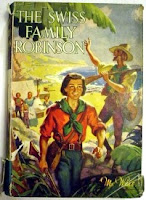
Wyss, Johann. The Swiss Family Robinson.
First published in 1812, this novel is about how one family survives a shipwreck and how they come to create a new home for themselves far away from civilization. I read the book because I have literally been hearing how *wonderful* it is my whole life. Yes, The Swiss Family Robinson is one of my mother's favorite books. But in childhood, the closest I could get to the novel--the closest I would get to the novel--was an abridged version. But even the abridged version, I gave up after a few chapters. So I was determined to not let 2008 go by without reading--really reading--this classic.
What did I think about it? Honestly? Well, it's still not my cup of tea. I still don't like it. The violence. The brutality. The absurdity. Granted in 1812, I'm sure it wasn't an absurd idea to kill animals for fun, for sport, or for a "learning" opportunity to learn what it was and how it worked. But for me, I saw it as a bunch of guys--a father and sons ranging in age from small to teen--who thrived on killing animals. True, some of the kills were for food or to protect their lives, but others seemed more trivial for me. Yes, the family needed to eat in order to survive. But I think some of it was pure overkill. But as I said, this wouldn't have ruffled any feathers in 1812 when it was published. I think--although I am not sure--that there was a philosophy that to study an animal meant to study the animal's corpse.
Besides the death of all those animals, and the passing dangers of island life, the book is filled with lessons and descriptions. The father has the need--and I'm not negating the need in actuality--to share every bit of knowledge in his head. And I'd be the first to admit, that if I were to be shipwrecked on an island, I'd want this guy around. First of all, he knows everything. It doesn't matter what subject. It doesn't matter how random or trivial, how broad or specific, this man knows it all. He knows how to do everything, how to make everything. This man is more knowledgeable than a walking set of encyclopedias. Now, if you were actually on the island and fighting for your survival. Receiving lessons of this sort, would be necessary and beneficial. To the ordinary reader--okay just this ordinary reader--some of the lessons are well, quite honestly, boring. You could skip these passages altogether and still follow the basic story.
One other thing that irritated me about the book. The woman never is given a name. The man isn't either, by the way, but he is the narrator. He is the "I" of the story so it isn't so obvious. The kids all have names. The animals all have names. The wife? Not named. I'd rather Grizzle the donkey be called "the donkey" or "that donkey" than to go 377 pages through a book where one of the main characters is simply called "the mother."
And it should be a crime what Wyss did to Grizzle by the way. Seriously. That's just wrong. It's beyond calloused or cruel.




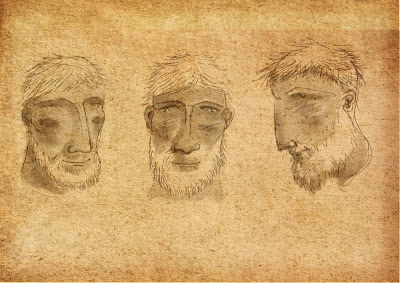


Jago, these are wonderful! I love all the color and the costumes. I was combing through the Picture Bookies Gallery and found you there. What wonderful creations spring from your mind and your hand.